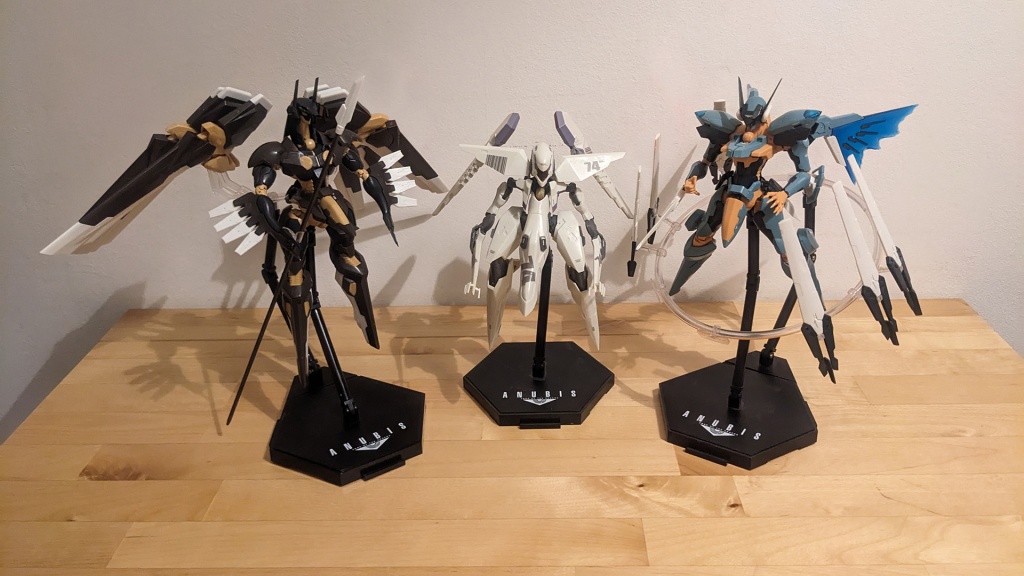Model-Kit “Anubis” – The Series Is Complete!
Anubis is the third and final model kit in my “Zone of the Enders” series. For those who have been following my blog posts, you know that my very first model kit was “Vic Viper,” and shortly after, I assembled “Jehuty.” Naturally, the last mecha (or “Orbital Frame” as they’re called in Z.O.E.) couldn’t be left out. However, things didn’t go smoothly during the assembly this time…
In general, Anubis doesn’t differ significantly from the other model kits. It’s actually the “easiest” to assemble because it doesn’t have stickers like Vic Viper nor tiny parts like Vic Viper or Jehuty. Nevertheless, the kit was delivered in a box twice the size of Vic Viper or Jehuty, because the body parts are slightly larger, and it includes a total of six wings (compared to Jehuty’s six small additional hover plates). As usual, I began by removing all the pieces from the grids, sanding off any remaining bits, and sorting them into bags labeled with letters according to the instructions.
When I started assembling the model in the second major step, I quickly noticed something was off: a piece was missing! It likely fell off unnoticed while I was removing pieces from the grids. I vaguely remember seeing it somewhere during that time (the process of removing pieces took several weeks). However, since I didn’t know what it belonged to (a cabinet? an electronic device?), I must have put it aside in an untraceable location or even discarded it. This piece was fortunately duplicated and is installed once in each of Anubis’s legs. Therefore, I could take a photograph of it and measure its dimensions. It appeared to be a joint but was, in fact, a sliding plate located at the back of the leg to conceal other joints.
I now had three options: (1) Simply continue assembling and ignore the missing piece (which was possible since it didn’t have a “supporting” role in the leg, it just left a gap), (2) reorder the piece, or more accurately, the grid, from the Japanese retailer, or (3) 3D print it myself. Option 1 was ruled out for the sake of completion, and Option 2 would have been prohibitively expensive. While there is a form to reorder individual grids from the instruction manual, the prices were quite high, all communication was in Japanese, I would need to use a Japanese proxy for ordering (meaning a pseudo-Japanese address, as delivery abroad wasn’t possible), and it was uncertain whether this service was even still offered, given that the Zone of the Enders model kits were quite old by then. In short, the third option was the only viable one left. However, this also proved to be not particularly straightforward. The piece was only a few centimeters in size and quite intricate. Most private 3D printers couldn’t print such a small part with the necessary precision, nor in a way that made it stable and not prone to breaking immediately upon assembly.
In solving the problem, René was the first to assist me. He recreated the piece in 3D as a digital model using Blender after I took countless reference photos of it from all angles. Finding someone with a 3D printer capable of printing such a small part proved to be challenging. Unfortunately, Christopher’s 3D printer could only print the piece too large. Fortunately, Juliane came to my rescue. With her Prusa MINI 3D printer, she was able to successfully print the pieces. She printed three of them in different sizes, with a 1-millimeter difference, and the largest one turned out to be the right fit.
Since the entire process of creating the digital 3D model and printing took quite a while, I had been working on other components of Anubis in the meantime. I also completed the simpler model kit of “Valimar,” which I have described in another post.
Overall, as mentioned at the beginning, Anubis was easier to assemble than Vic Viper or Jehuty (not as easy as Valimar, but that’s a different manufacturer). However, I encountered another problem towards the end. In short, another piece was missing, but that wasn’t the main issue. It was about Anubis’ “tail,” which is a long cable. In the model, it’s made of soft plastic with a wire inside, allowing the cable to be bent freely. I was missing the connector to the body, and there was also an issue with the end of the tail. There was a kind of “blade,” but it didn’t fit onto the cable, and it’s not properly shown in the instructions (only the connection to the body is illustrated). It seems like the pieces and the instructions weren’t properly coordinated. This is further reinforced by the fact that I ended up with about 5 pieces left over that weren’t shown in the preview grid in the instructions and weren’t used anywhere in the model. So, it’s questionable whether the beginning and the end of the tail would have fit properly in any case. In the end, I decided to omit this part when assembling the model.
Due to the wings and the spear, the Anubis model has become significantly larger than Vic Viper or Jehuty. And even though it was theoretically easier to assemble (excluding the missing pieces, for which I’m not entirely blameless), I still found Jehuty and especially Vic Viper to be better. This is simply because Jehuty can not only move due to its joints but can also transform into its jet form, which is still quite cool for a model. However, I am proud to have completed all three models. Theoretically, there is another Jehuty model without weapons as a simpler version, but I practically already have that one in my collection. Additionally, it’s unlikely that more mechas from Z.O.E. will be released by KOTOBUKIYA. This is because the series has been concluded for over 15 years (apart from a few remasters), and with Hideo Kojima leaving Konami, it’s unlikely that the series will be touched or extended with a new installment.


